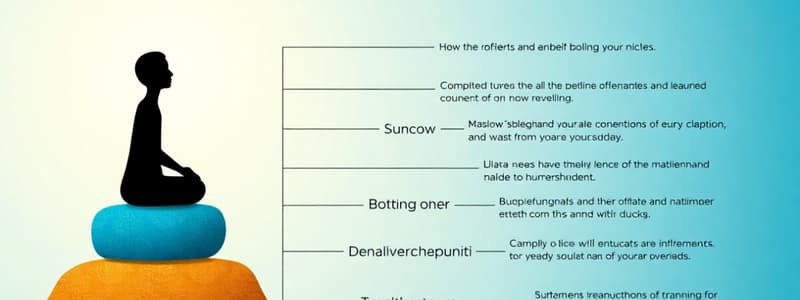Podcast
Questions and Answers
Which of the following is the highest tier in Maslow's Hierarchy of Needs?
Which of the following is the highest tier in Maslow's Hierarchy of Needs?
- Safety Needs
- Self-Actualization Needs (correct)
- Physiological Needs
- Esteem Needs
Deficit needs in Maslow's hierarchy include only physiological and safety needs.
Deficit needs in Maslow's hierarchy include only physiological and safety needs.
False (B)
What are 'B-Needs' in Maslow's Hierarchy?
What are 'B-Needs' in Maslow's Hierarchy?
Being Needs, which focus on self-actualization and personal growth.
Maslow's Hierarchy of Needs is depicted as a _______ structure.
Maslow's Hierarchy of Needs is depicted as a _______ structure.
Match the levels of Maslow's Hierarchy with their descriptions:
Match the levels of Maslow's Hierarchy with their descriptions:
At which level of Maslow’s hierarchy do individuals seek relationships and social connections?
At which level of Maslow’s hierarchy do individuals seek relationships and social connections?
According to Maslow's theory, higher-level needs can be pursued without fulfilling lower-level needs.
According to Maslow's theory, higher-level needs can be pursued without fulfilling lower-level needs.
Name one application of Maslow's Hierarchy of Needs.
Name one application of Maslow's Hierarchy of Needs.
The _______ Needs level includes self-esteem and achievement.
The _______ Needs level includes self-esteem and achievement.
Flashcards are hidden until you start studying
Study Notes
Maslow's Hierarchy of Needs
-
Overview: A psychological theory proposed by Abraham Maslow, depicting human needs in a five-tier pyramid.
-
Levels of Needs:
-
Physiological Needs:
- Basic survival needs: food, water, warmth, and rest.
-
Safety Needs:
- Security and safety: physical safety, financial security, health, and well-being.
-
Love and Belongingness Needs:
- Emotional relationships: friendships, family, intimacy, and social connections.
-
Esteem Needs:
- Recognition and respect: self-esteem, status, achievement, and recognition from others.
-
Self-Actualization Needs:
- Personal growth: the realization of personal potential, creativity, and self-fulfillment.
-
-
Key Concepts:
- Progression: Individual must satisfy lower-level needs before addressing higher-level needs.
- Deficit Needs: Levels 1 to 4 are considered deficit needs, which can lead to negative feelings if unmet.
- Being Needs (B-Needs): Level 5 (self-actualization) is referred to as being needs, focusing on personal growth and peak experiences.
-
Criticism:
- Lack of empirical support and inconsistency in the strict progression of needs.
- Cultural bias, as needs may vary across different cultures and individuals.
-
Applications:
- Used in psychology, education, healthcare, and workplace motivation.
- Helps in understanding human behavior and motivation towards personal and professional goals.
Maslow's Hierarchy of Needs
- Maslow's Hierarchy of Needs is a psychological theory that describes human needs in a five-tier pyramid.
- Physiological Needs: These are basic survival needs like food, water, warmth, and rest.
- Safety Needs: These focus on security and safety in aspects like physical safety, financial security, health, and well-being.
- Love and Belongingness Needs: This level emphasizes emotional relationships, including friendships, family, intimacy, and social connections.
- Esteem Needs: These relate to recognition and respect, covering aspects like self-esteem, status, achievement, and recognition from others.
- Self-Actualization Needs: This highest level focuses on personal growth and the realization of individual potential, creativity, and self-fulfillment.
- Maslow's theory suggests that individuals must satisfy lower-level needs before addressing higher-level needs.
- Deficit Needs: The first four levels ( Physiological, Safety, Love & Belongingness, Esteem) are considered "deficit needs," meaning their unmet needs can lead to negative feelings.
- Being Needs (B-Needs): The fifth level, self-actualization, is referred to as "being needs," focused on personal growth and peak experiences.
- Criticisms: Maslow's theory has faced criticism for lack of empirical support, inconsistency in the strict progression of needs, and potential cultural bias.
- Applications: Maslow's theory is used in various fields including psychology, education, healthcare, and workplace motivation. It helps in understanding human behavior and motivation toward personal and professional goals.
Studying That Suits You
Use AI to generate personalized quizzes and flashcards to suit your learning preferences.




